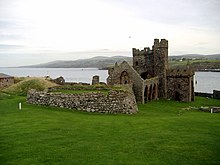Catholic Church in the Isle of Man
[1] Furthermore, after baptizing Irish clan chief and pirate leader Maughold, St. Patrick ordered the latter to do penance for his past crimes and to abandon himself to the Christian God by sailing alone from Ireland in a currach without oars.[2] Some scholars in recent centuries have identified a distinctive Celtic Church, to which Catholics, Protestants, and Eastern Orthodox Christians have all claimed in historical debates to be the only legitimate heirs.In the Celtic Church, attitudes towards clerical celibacy were more relaxed, a differing form of monastic tonsure was used, the use of prayer beads known as the Pater Noster cord preceded the invention of the rosary by St Dominic, and the lunar method was used for calculating the date of Easter.During the 1960s, Frank O'Connor explained that the reason why, on both sides of the Irish Sea, abbots were often more powerful than bishops is because a Church governed by an Episcopal polity, "in a tribal society was a contradiction in terms."[3] Also, despite a shared belief in the Real Presence in the Eucharist, the veneration of the Blessed Virgin, and shared use of the Ecclesiastical Latin liturgical language, as is documented by primary sources such as the Stowe Missal, there were often significant differences between the Celtic Rite and the mainstream Roman Rite[4][5] and evidence of a distinctive form of Celtic chant in Latin, which is most closely related to Gallican chant, also survives in liturgical music manuscripts dating from the period.At the beginning of the English Reformation, the Act of Supremacy declared King Henry VIII the Supreme Head of the Church in all his dominions and defined even unspoken mental reservation as high treason.From 1779 a Benedictine monk, Father Johnston, who served the mission at St. Begh's Whitehaven, started to make regular pastoral calls - he noted some 29 Catholics living on the Island.In 1789 a French émigré priest, Father Louis, sought asylum on the Island; for a time he acted as tutor to the governor's and bishop's children whilst living at Castle Rushen.When Fr McPharlan fled to the Island around 1804, to escape debts incurred in setting up a brick factory for his Irish parish, he made contact with Major Taubman who donated a site within the disused quarry on the Douglas-Castletown road, for Catholic worship.


Catholic Church by countryAfricaAlgeriaAngolaBotswanaBurkina FasoBurundiCameroonCape VerdeCentral African RepublicComorosDemocratic Republic of the CongoRepublic of the CongoDjiboutiEquatorial GuineaEritreaEswatiniEthiopiaGambiaGuineaGuinea-BissauIvory CoastLesothoLiberiaMadagascarMalawiMauritaniaMauritiusMoroccoMozambiqueNamibiaNigeriaRwandaSão Tomé and PríncipeSenegalSeychellesSierra LeoneSomaliaSomalilandSouth AfricaSouth SudanTanzaniaTunisiaUgandaZambiaZimbabweAfghanistanBangladeshBhutanBruneiCambodiaEast TimorHong KongIndonesiaKazakhstanNorth KoreaSouth KoreaKyrgyzstanMalaysiaMaldivesMongoliaMyanmarPakistanPhilippinesSingaporeSri LankaTaiwanTajikistanThailandTurkmenistanUzbekistanVietnamMiddle EastArmeniaAzerbaijanBahrainCyprusGeorgiaAbkhaziaIsraelJordanKuwaitLebanonPalestineSaudi ArabiaTurkeyUnited Arab EmiratesEuropeAlbaniaAndorraAustriaBelarusBelgiumBosnia and HerzegovinaBulgariaCroatiaCzechiaDenmarkEstoniaFinlandFranceGermanyGreeceHungaryIcelandIrelandKosovoLatviaLiechtensteinLithuaniaLuxembourgMoldovaMonacoMontenegroNetherlandsNorth MacedoniaNorwayPolandPortugalRomaniaRussiaSan MarinoSerbiaSlovakiaSloveniaSweden
